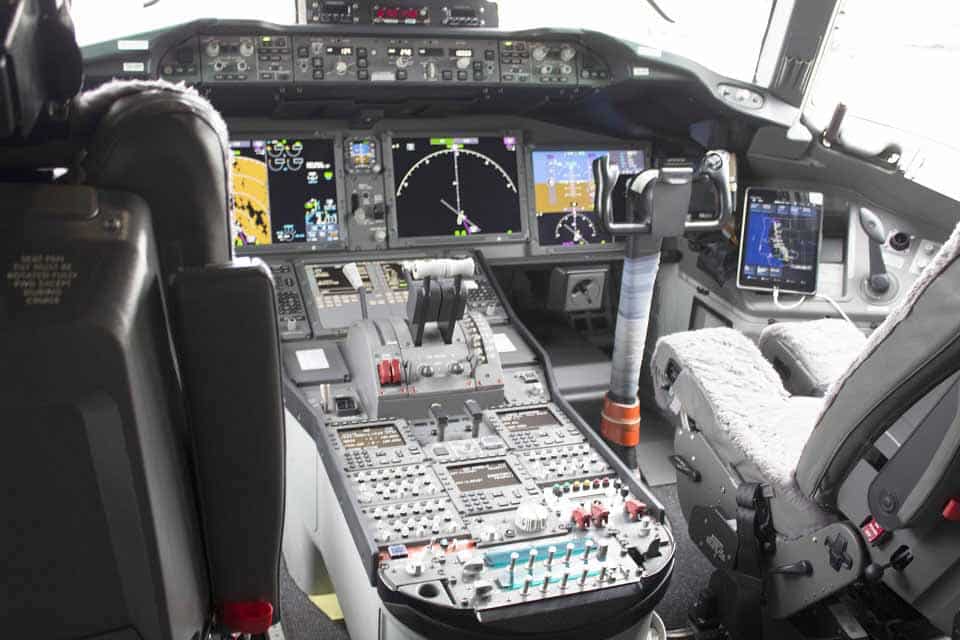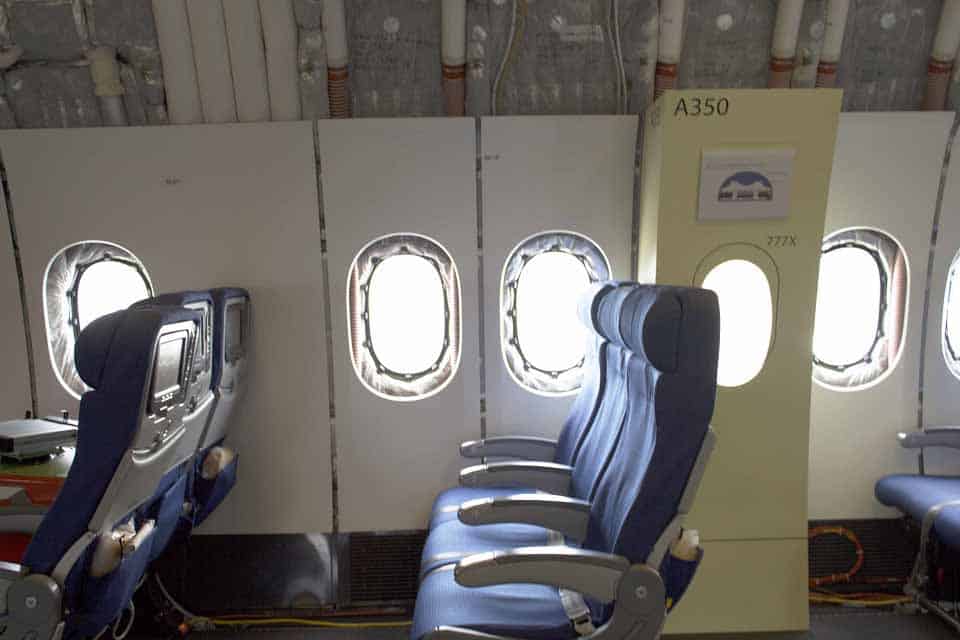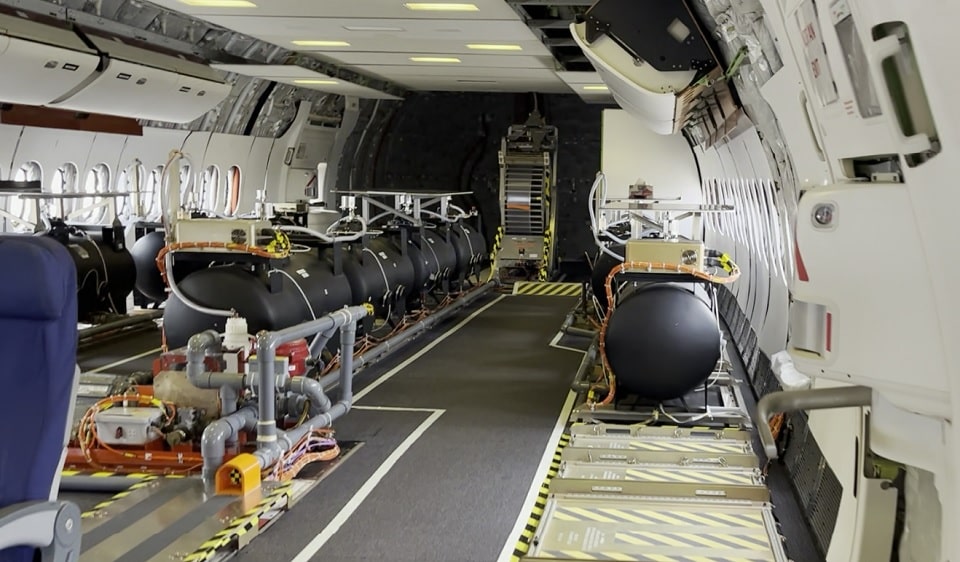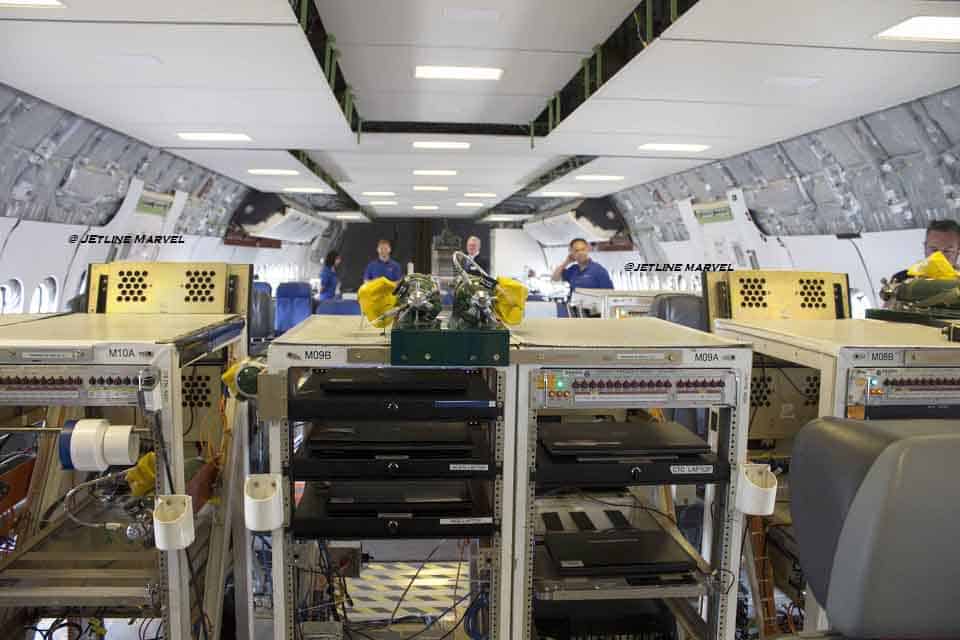Aerospace
A Peek Inside BOEING 777X Test Flight at Paris Airshow.

Have you ever wondered, How aircraft undergo the process of earning final approval certificates from the FAA or EASA for passenger flight operations after testing?
Let’s have a look at it in the article below. Before building a physical model, the aircraft undergoes extensive design and material selection. As well as testing to determine its requirements and viability.
Jetline Marvel received permission to visit the inaugural Boeing 777-9 at Paris Airshow 2023. Granting a unique opportunity to glimpse the typically undisclosed aspects of the aerospace industry..
Boeing redesigned the Boeing 777x and B737. Giving them a more contemporary appearance, more spacious cabin, and more sophisticated amenities than the models that came before.

Take into consideration that the aircraft has an even larger engine to increase its speed and carrying capacity. The massive fan is only marginally smaller than the fuselage of a Boeing 737, with a diameter of 128 inches. The GE90-115B held the title of the world’s largest jet engine. Until the introduction of the even larger GE9X for the 777X. Although the engine has a diameter of 134 inches, it does not have the same thrust as the GE90.
Safety in the Skies: How Boeing Ensures Airworthiness Through Testing
Boeing’s 777X test planes, Including the 777-9 variant, feature a range of instruments and systems tailored for flight testing and validation.
These test aircraft assess the aircraft’s performance, safety, and compliance with regulatory requirements before it is ready for commercial service. Here are some of the key components and features typically found inside a Boeing 777X test plane.

Flight Testing the Boeing 777X and B737: What Goes Onboard
Boeing 737-10 and Boeing 777 planes are experimental aircraft. Which are the forthcoming Boeing family aircraft that are currently in the testing process. The B737 Max has undergone minor fitness improvements. Boeing 777X is presently undergoing critical testing phases for its components, with an anticipated completion timeline of another 18 months.
Both aircraft arrived at the 2023 Paris Airshow. They permitted a few reporters to take a look inside the plane. It appears incredible to view the experimental airplane.

From Instruments to Ballast Tanks: The Tools of Aircraft Certification
The interior is designed to accommodate over 400 passengers in a standard two-class commercial layout. Resembles a vast, open space filled with numerous instrument racks.
Even the lateral walls, were devoid of wall finishings and fixtures. contributed to the overall work-in-progress feel of the space.
The large tanks you can see in this photo are at the back of the aircraft and serve a number of important functions for it to understand its own motion.

To achieve the required balance when the center of gravity of an aircraft or ship falls outside specified tolerances or the designated position, operators use ballast, which primarily consists of rubber or sand.
Engineers need to transfer water between the tanks to calculate the maximum weight balance of the aircraft under cruising conditions.
Difference between the Airbus A350 and B777x
Here is the difference between the Airbus A350 and B777x fuselage size which is quite bigger than A350 aircraft and the windows are slightly larger as well.
The cockpit boasts a modern design and incorporates cutting-edge avionics and engine features, elevating the aircraft’s capabilities.
In the aircraft, there are seats in the middle and on the right side, all of which come with soundproof covers. One of the middle seats also has a sensor installed. The left and right sides of the cabin have designated walking areas.
The difference between the Airbus A350 and B777x can be found in this article.

Furthermore, if you continue moving to the rear, you will notice some of the tanks that will be filled with water based on their weight
On the right side, we can see one of the engineers can sit and monitor the sensors and outside views. Most of the seats in the airplane are in the middle, where computers and sensor panels are arranged along with all the wires and sensors.
according to the weight load balance during the flight test mode. Internally coupled with pipers and pressure tanks, the tanks can instantaneously flow water within each other.

As we move back, we can see one of the controllers, which is usually used to manage the water lines.
At the back end, we can see the fuselage encased and insulated with soundproof materials, which works as a shield for the aircraft fuselage.
There are approximately four tanks on each side of the row, with around twelve tanks at the back end. We can see outside from the plane’s window and door.

More computers and sensor monitoring chambers appear as we proceed. Engineers’ tasks are critical since they ensure that each test phase is completed. Some of the other journalists are shooting pictures inside the plane.
The aircraft looks impressive even prior to the installation of its seats. Understanding the variations in the aircraft’s data is made possible by the fact that the majority of the sensors are connected to different parts of the aircraft.
Furthermore, the aircraft is being equipped with the following types of instruments and equipment:
- Flight Test Equipment: Test planes have special tools and sensors to gather data about how well the aircraft works. They look at things like how it flies, its technology, and how strong it is.
- Controlling the Aircraft: They check if the systems that control the plane, like the fly-by-wire system, work the right way and are safe.
- Measuring Stress and Load: Sensors are put in different parts of the plane to see how much stress and pressure it can handle during the tests.
- Engineers on Board: Engineers are on the plane to keep an eye on everything, collect data, and make decisions during the tests.
- Computer Programs: They use special computer programs to study the data from the tests. This helps them see how well the plane is doing and what they can make better.
- Special Tools: Sometimes, they use special equipment, like tanks filled with weights, to copy different conditions during the tests.
- Safety First: Safety is a big deal, with backup plans and systems to keep the test crew and the plane safe.
- Like a Prototype: The test plane is like a prototype or an early version of the plane, so it might not have all the fancy features and systems of the final passenger plane.
Please share your thoughts on this article in the comments section. We would also be interested in hearing about any suggestions you may have for future aviation-related articles.

Aerospace
Boeing Transfers Rocket Stage to NASA, Paving Way for Human Moon Mission

Boeing has achieved a significant milestone by providing NASA with the second core stage of the Space Launch System (SLS) rocket.
This crucial component, crafted at NASA’s Michoud Assembly Facility (MAF), is set to propel the Artemis II crew into lunar orbit, marking humanity’s return to deep space after a 50-year hiatus.
The monumental Boeing-built rocket stage, the largest element of the Artemis II mission, will embark on a journey aboard the Pegasus barge, traveling 900 miles to NASA’s Kennedy Space Center.
Comparison of two legendary aircraft B777x vs B747 aircraft:Click here
Upon arrival, it will be meticulously integrated with other essential Artemis II components, including the upper stage, solid rocket boosters, and NASA’s Orion spacecraft within the iconic Vehicle Assembly Building. This intricate integration process is a vital step toward the eagerly anticipated Artemis II launch, slated for 2025.
“Boeing-built products helped land humankind on the moon in 1969, and we’re proud to continue that legacy through the Artemis generation,” remarked Dave Dutcher, vice president and program manager for Boeing’s SLS program. “Together, with NASA and our industry partners and suppliers, we are building the world’s most capable rocket and paving the way to deep space through America’s rocket factory in New Orleans.”
NASA, Lockheed Martin Reveal X-59 Quiet Supersonic Aircraft:Click here
The delivery of Core Stage 2 marks a significant achievement in the evolution of the SLS rocket. Towering over 200 feet and powered by four RS-25 engines, this core stage, coupled with two solid-fueled booster rockets, will generate a staggering 8.8 million pounds of thrust. This immense power is crucial to launching Artemis II and future missions into the vast expanse of space.
The SLS rocket stands unparalleled in its capability to transport both crew and substantial cargo to the moon and beyond in a single launch. Its extraordinary capacity will facilitate the delivery of human-rated spacecraft, habitats, and scientific missions to destinations including the moon and Mars, ushering in a new era of space exploration.
-

 Travel1 week ago
Travel1 week agoAir India to Expand US Operations with Three New Routes After a Decade
-

 Travel2 weeks ago
Travel2 weeks agoWhy We Should Avoid These Stamps in a Passport
-

 Airlines1 month ago
Airlines1 month agoInvestigations Reveal Fake Chinese Titanium in Boeing and Airbus Jets
-

 Tech4 weeks ago
Tech4 weeks agoChina’s CATL Plans 1,800-Mile Electric Plane Launch by 2027
-

 Airport3 days ago
Airport3 days agoTop 10 Largest Airports in the World by Size
-

 Aerospace4 weeks ago
Aerospace4 weeks agoChina’s Fighter Jets Turn Wings into Autonomous Drones
-

 Airlines4 days ago
Airlines4 days agoAir India Rolls Out A350s for Delhi-New York JFK and Newark Routes
-

 Defence3 weeks ago
Defence3 weeks agoBoeing Enhances Chinook with New Engines and Block II Upgrades at $96 Million







